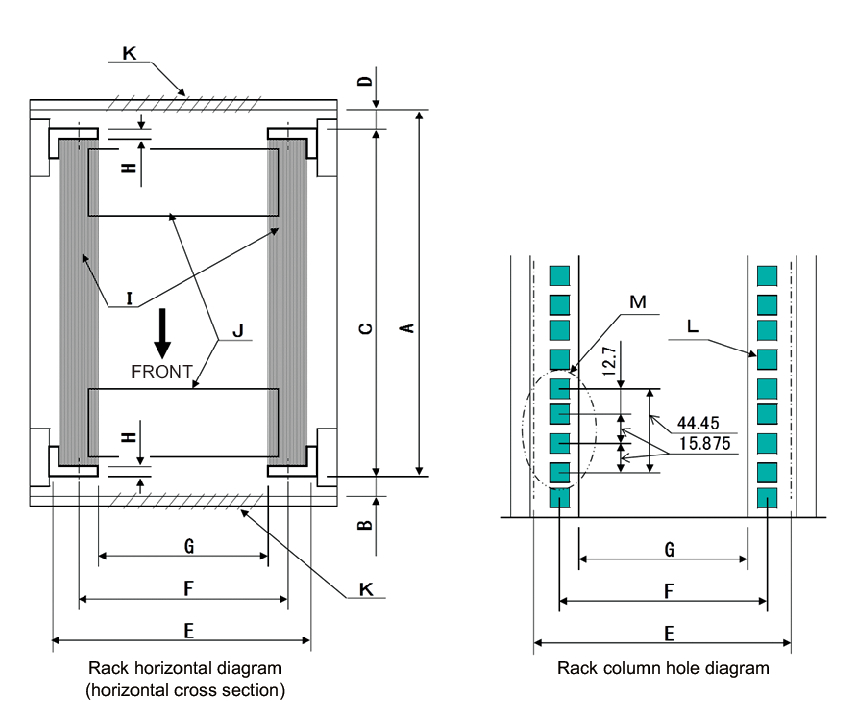2.4.1 Mounting Conditions for General Racks
2.4.1 Mounting Conditions for General Racks
The SPARC M12-1 is designed for mounting in an equipment rack.
For mounting in a third-party rack, it is the customer's responsibility to confirm that the rack specifications match the product specifications and requirements for the SPARC M12 systems (see Figure 2-2 and Table 2-3).
|
Figure 2-2 Dimensional Drawings for Third-Party Rack Checks
|

|
| Note - The dimensions shown in the conditions do not include any protrusions. |
| Description | Condition | Letter in Figure |
|---|---|---|
| Rack type/Compliance standards | Equipment rack/EIA standard-compliant | -- |
| Dimension between rear door (inside) and front column | SPARC M12-1: At least 917 mm (36.1 in.) PCI-BOX: At least 848 mm (33.4 in.) |
A |
| Dimension between front door (inside) and front column | SPARC M12-1: At least 40 mm (1.5 in.) PCI-BOX: At least 24 mm (0.9 in.) |
B |
| Dimension between front and rear columns | Within adjustment range of rack mount kit Adjustment range of the mount kit for each server SPARC M12-1: 612 mm (24.1 in.) to 925 mm (36.4 in.) PCI-BOX: 630 mm (24.8 in.) to 840 mm (33.1 in.) |
C |
| Dimension between rear door (inside) and rear column | SPARC M12-1: No conditions PCI-BOX: At least 158 mm (6.2 in.) |
D |
| Front panel mounting space of chassis | At least 483 mm (19.0 in.) | E |
| Distance between left and right chassis attachment holes (common to front and rear columns) | 465 mm (18.3 in.) |
F |
| Distance between left and right columns (common to front and rear columns) | At least 450 mm (17.7 in.) | G |
| Column thickness | 2 mm (0.08 in.) to 2.5 mm (0.1 in.) |
H |
| Structures other than columns | Rack has no structures between front and rear columns | I |
| Cable hatch | Rack has hatch on bottom surface, rear door, or elsewhere | J |
| Area of door vent openings | Front door: At least 73 % of door area Rear door: At least 73 % of door area |
K |
| Size of chassis attachment holes (common to front and rear columns) | SPARC M12-1: Square hole with sides longer than 9 mm (0.35 in.) and not longer than 9.8 mm (0.38 in.), or M6 screw hole PCI-BOX: Square hole with sides longer than 9.2 mm (0.36 in.) and not longer than 9.8 mm (0.38 in.) (*1), or M6 screw hole |
L |
| Vertical pitch of chassis attachment holes (common to front and rear columns) |
EIA standards, universal pitch | M |
| Door opening angle | Door opens to 130° | -- |
| Strength | Rack has necessary strength/load capacity for mounting chassis | -- |
| Grounding | Rack and units can be grounded | -- |
| Toppling prevention measures | Rack can be prevented from toppling over | -- |
| Earthquake resistance measures | Earthquake resistance measures can be implemented for rack | -- |
| *1 If the PCI expansion unit has square holes with sides 9.0 mm (0.35 in.) to 9.2 mm (0.36 in.) wide, a rack mount kit needs to be prepared. | ||
- Handling cables inside the rack
For maintenance work on the SPARC M12-1 and its expansion with optional components, the chassis may be pulled out from the front of the rack. If the chassis is mounted in a third-party rack, the cable management arm may not be attached to the rack. Even if it is attached, it may not function normally. If the cable management arm is not attached, the chassis cannot be pulled out from the rack with the cables still connected. In such cases, power off the chassis and then disconnect the cables. After that, pull out the chassis. - Other conditions
In addition to structural conditions, the following condition must be taken into consideration.- Considering cooling inside the rack, install the rack such that the temperature of the product mounted in the rack meets the temperature conditions. For details, see "2.5 Checking Environmental Conditions." Particularly, make sure that exhaust from the chassis does not re-enter the chassis through the air intakes. This requires measures such as covering the front and rear of empty spaces inside the rack.
< Previous Page | Next Page >